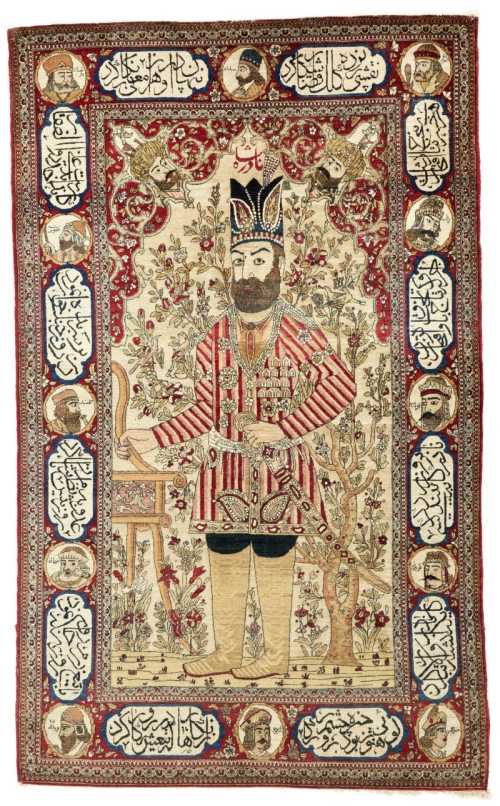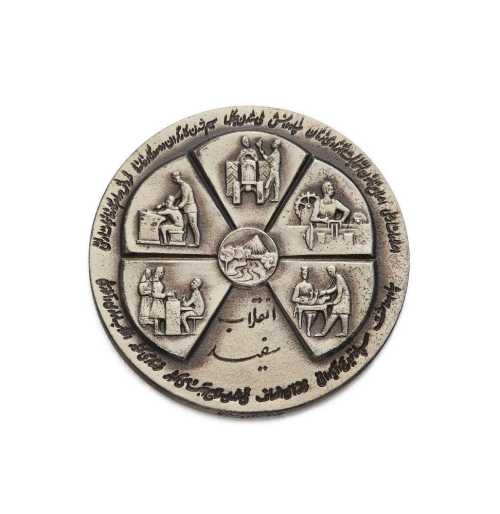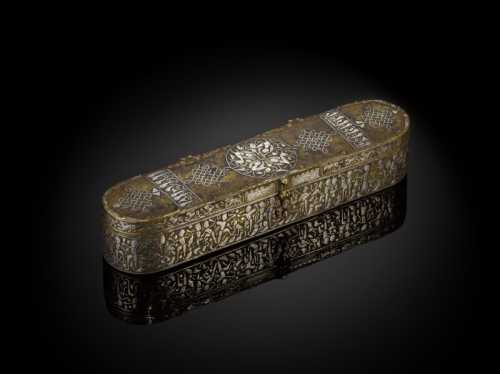- A fine Khurasan silver-inlaid brass penbox, Persia, circa 1200 1200
- Handicrafts and classics, Metal
- of elongated ovoid form with a hinged top, the surface of the body decorated with figures fighting and banqueting, the upper part of the lid with anthropomorphic Kufic inscriptions to each end and a central roundels containing four harpies against a foliate ground, around the lid and inside, bands of running hares and other feline animals25cm.
Estimation
£200,000
261,780 USD
-
£300,000
392,670 USD
Realized Price
£252,000
329,843 USD
0.8%
Artwork Description
On the top: ‘Glory and prosperity and wealth and happiness’; on the sides: ‘Glory and prosperity and wealth and happiness and well-being and (God’s) grace and health and sympathy and (Prophet’s) intercession and (…) and contentment and (God’s) grace (..)'
This magnificent penbox is a fine surviving example from Khurasan's metalware workshops in the late twelfth and early thirteenth century. Conserving most of the original inlay, it presents lively scenes of court life, depicting warriors, musicians and banqueters.
The lid is decorated with a central round encircling four harpies among vines terminating in rabbit and dog heads. The theme of harpies was common in Khurasan metalware workshops of the time, and can be found around the shoulder of a ewer in the Metropolitan Museum of Art (inv. no.44.15; published in Carboni 1997, p.24) and on two trays now in the Victoria & Albert Museum (inv. nos.181-1951 and 32-1954, both published in Melikian-Chirvani 1982, nos.29 and 36, pp.100 and 105). The harpies are encircled by vines terminating in rabbit or dog heads, another recurrent motif on contemporaneous metalwork. Similar vines are found on the Metropolitan ewer and on a qalamdan now in the Louvre (inv. no.MAO2228). The central roundel on the lid is flanked by a band of anthropomorphic calligraphy enclosed by two delicate knotworks; a similar knotwork is present on a ewer now in the Victoria and Albert Museum, dated slightly later, to the first half of the thirteenth century (inv. no.592-1898, published in Melikian-Chirvani 1982, p.116, no.45). The bands of hares chased by dogs which run around the side of the lid and inside the box are comparable to those found on a contemporaneous ewer in the British Museum (inv. no. 1848,0805.2; published in Ward 1993, p.56).
The hinges which run on the lid are testament to the original shape and material of such penboxes, which would have been ivory or wood, as such clasps are unnecessary in metal; for a comparable penbox showing hinges and clasps, see an example attributed to Iran, circa 1200, now in the David Collection, Copenhagen, inv.no.11/1982.
The body of the penbox presents an unusual and lively scene, with various characters engaged in different activities, from fighting with bows and arrows, to playing instruments such as the lute, the harp and the tambourine, to cheering and pouring drinks into cups. A very similar band runs above the zodiac signs on the Vaso Vescovali in the British Museum (inv. no. 1950,0725.1; published in Ward 1993, p.57).
More lots by Unknown Artist

An Isfahan pictorial rug, Central Persia, circa 1910
Estimation
£4,000
5,236 USD
-
£6,000
7,853 USD
Realized Price
£5,670
7,421 USD
13.4%
Sale Date
Sotheby's
-
30 March 2022

A gold medal commemorating the coronation of Muhammad Reza Shah and Queen Farah
Estimation
£100
132 USD
-
£200
263 USD
Realized Price
£160
211 USD
6.667%
Sell at
Sale Date
Rosebery's Auction
-
1 April 2022

A silver memorial medal of the White Revolution, Muhammad Reza Shah, 1967
Estimation
£200
263 USD
-
£300
395 USD
Realized Price
£170
224 USD
32%
Sell at
Sale Date
Rosebery's Auction
-
1 April 2022
Realized Price
67,245 USD
Min Estimate
35,481 USD
Max Estimate
53,247 USD
Average Artwork Worth
+83.63%
Average Growth of Artwork Worth
Sales Performance Against Estimates
Average & Median Sold Lot Value
2021 - 2025
Performance vs. Estimate
2021 - 2025
Sell-through Rate
2021 - 2025
Similar Artworks

A fine and rare silver incense burner, Mesopotamia, Persia or Central Asia, 10th-12th century
Estimation
£250,000
327,225 USD
-
£300,000
392,670 USD
Realized Price
£315,000
412,304 USD
14.545%
Sale Date
Sotheby's
-
30 March 2022








